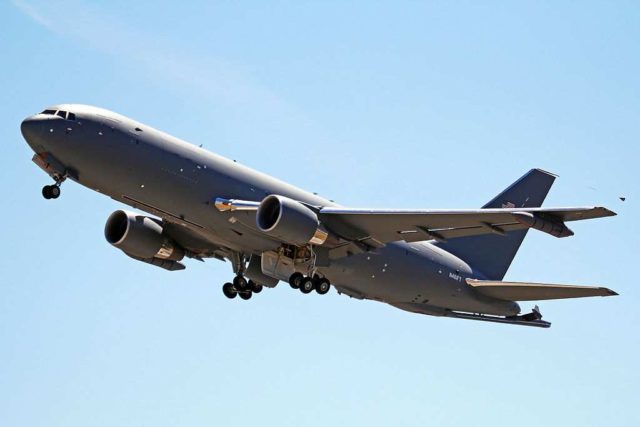
Boeing poised to score billions in Biden’s Pentagon budget request aerial refueling tanker (Ken Fielding/WikiCommons)
Hammered by several years of losses within its commercial plane-making business, Boeing now stands to gain billions of dollars in defense work if Congress green-lights the Biden administration’s 2023 budget request.
Projects run by the Chicago-based aerospace and defense giant were front and center in the spending proposal sent to lawmakers on Monday. And comments made by senior defense officials hint that even more business could be on the way.
The largest revelation is that Air Force might not hold a competition for its next class of aerial refueling tankers. Instead, the service might just go with a modified version of the KC-46, a Boeing-made aircraft whose development problems have cost the company more than $5 billion.
“As we…look further out, the requirements start to look like a modified KC-46 more than they do a completely new design,” Air Force Secretary Frank Kendall told reporters Friday. “So, we’re working our way through that and finalizing those requirements.”
The Air Force is in the process of buying 179 KC-46 tankers, which are converted Boeing 767 airliners. The full contract is worth about $35 billion. Last year, the Air Force began its search for 160 additional tankers. Lockheed Martin and Boeing’s European-rival Airbus have formed a partnership to pitch a modified A330 airliner, branded the LMXT, the KC-46’s main competitor in the international market.
“I think there’s still a possibility of a competition out there, but as we’ve looked at our requirements, the likelihood of a competition will come down,” Kendall said.
If the LMXT is allowed to compete, its makers will surely point to the A330 tankers that have been refueling military aircraft on air-defense missions along NATO’s eastern front since Russia’s invasion of Ukraine. The companies want to assemble the LMXT in Mobile, Alabama, and then do military modifications in Marietta, Georgia. Some lawmakers have been beating the Lockheed-Airbus drum for several months.
“The American-built LMXT strategic tanker offers excellent value and complementary capability for the U.S. Air Force as it prepares for future tanking requirements in the near-peer fight,” Stephanie Stinn, a Lockheed spokeswoman, said in an emailed statement. “We support the Air Force as it determines its path forward for its future tanking fleet, and are prepared to offer a ready and proven solution in the LMXT if there is a competition.”
Another prospective big score for Boeing in Biden’s proposal is the Air Force’s $1.4 billion plan to buy 24 F-15EX fighters in 2023 and in each of the next few years.
“We will do that for the next couple years or so,” Maj. Gen. James Peccia, deputy assistant Air Force secretary for budget, said Friday.
Meanwhile, the Air Force wants to buy fewer Lockheed F-35 stealth fighters than originally planned in the next few years.
“Given an F-35A production line that today can build 80 F-35As annually, this is truly high-risk to a vital program,” David Deptula, a retired Air Force lieutenant general who is now dean of the Air Force Association’s Mitchell Institute, said in a statement. “The choice to accelerate purchases of the F-15EX—a valuable, but technologically inferior airplane—is helpful, but not adequate to shore up the Air Force’s declining combat capacity.”
The Air Force’s Kendall said the service is committed to the stealth fighter, but wants to slow its purchase due to problems with upgrades for the jet.
The service also wants to retire 33 F-22 Raptors. Lockheed would lose maintenance and upgrade money if those jets are retired.
Kendall also said Boeing’s E-7 Wedgetail is the “leading candidate” to replace the E-3 Sentry, better known as the airborne warning and control system, or AWACS.
The Air Force also plans to shrink its Lockheed-made C-130 tactical cargo plane fleet from 279 to 271; and to cut its planned fleet of 113 HH-60W Jolly Green II helicopters to 75.
Meanwhile, the Army wants to buy 35 Boeing-made Apache attack helicopters, five more than originally planned.
The new budget proposal includes a few program cuts for Boeing too. The Navy wants to buy no F/A-18 Super Hornets; it also requested none last year, but Congress added 12 jets. It also requested no V-22 Ospreys as procurement of the tiltrotor looks poised to end. Finally, there are no P-8 submarine hunters, but the Wedgetail procurement would be done on the same Renton, Washington, assembly line.
Lockheed stands to gain by the Air Force’s plan to increase production of stealthy JASSM cruise missiles.
___
© 2022 Government Executive Media Group LLC Distributed by Tribune Content Agency, LLC




